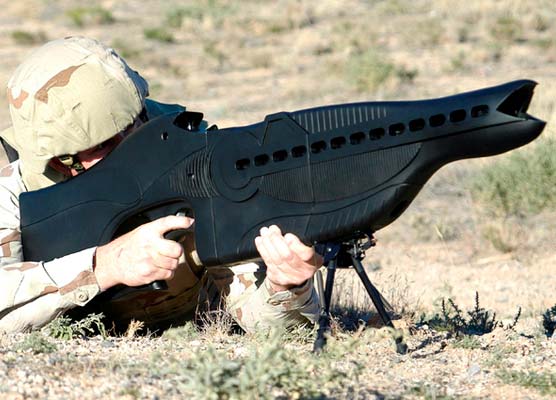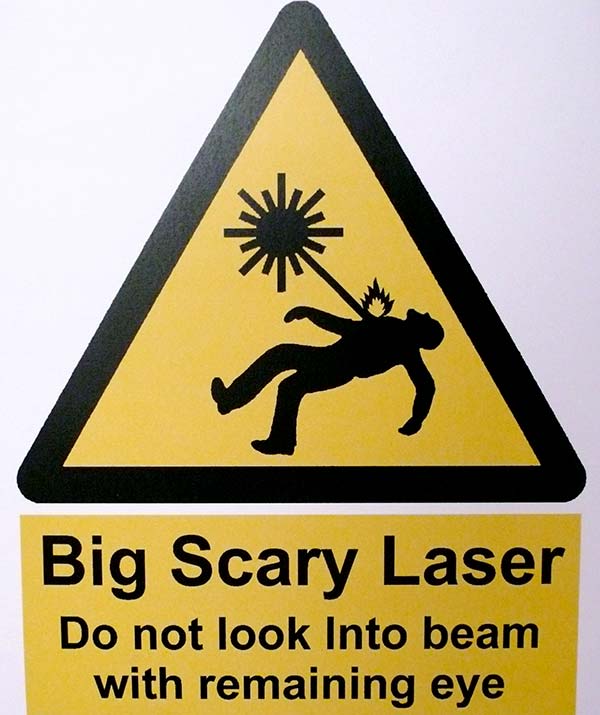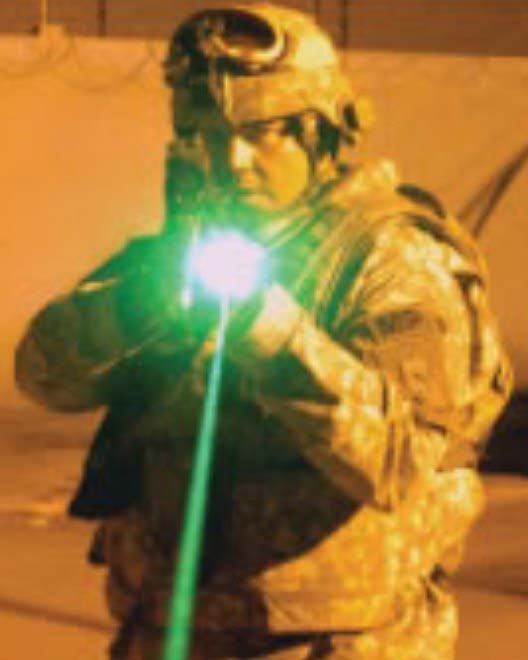Laser Rifles
Are Coming!
If You Can See It, You Can Hit It — To The Horizon
Lasers are not actually rifles, but they can resemble long guns.
At high power, lasers are deadly light sources. Truck-mounted, airborne and ship-based lasers with ten to more than a thousand horsepower have shot down mortar rounds, artillery rounds, drones, UAV’s and missiles. There are no declassified programs for infantry laser anti-personnel weapons. However, the technology exists to make and deploy man-portable laser weapons.
Lasers convert electrical power into light energy traveling in one direction, just as gunpowder starts a bullet on its trajectory. Electricity can come from batteries or man-portable generators. Their beams deliver energy concentrated into a small area, the same way a bullet does. Lasers pulse like an automatic rifle; continuous lasers that hose-down the target are too heavy for infantry. With a laser, one squeezes off shots or holds down the trigger and the pulses come as fast as the laser can cycle. They generate spot temperatures hotter than the surface of the sun and will burn through any material known to man.
Why else are the US and other nations developing laser weapons? Initially there will be significant psychological harm to those on the receiving end of a laser assault. Laser rifles have advantages: no magazines to change, no recoil, no supersonic bang or muzzle flash (for IR/UV lasers). No adjusting for range, leading or windage. The weight of the ‘ammunition’ (i.e. fuel) per shot is 95 percent less than for bullets and the cost per shot can be 99 percent less. Finally, lasers can start fires at longer range more efficiently than other weapons.
Lasers shoot straight — if you can see it, you can hit it. An anything from your vantage point to the horizon can be struck. The beam, like a bullet, loses power with distance. Still, a laser could hit targets farther away than any sniper rifle.
We have almost no information yet on the effects of potentially lethal laser pulses on people. For now we must assume the lethality of the laser energy absorbed is similar to a wound from a round of the same muzzle energy.
Variables
Air temperature and humidity affect the beam’s path to the target. Laser beams, like normal light, bend slightly in air as if they are passing through a prism. However, given software with computer optical control, the shooter aims with the holographic sight, pulls the trigger and the laser puts a low power spot on the target. The computer then walks the spot onto the aiming point and fires at full power, all within microseconds.
Laser rifles need a portable power source. Given that a 25 lb. backpack two-stroke leaf blower engine generates 4 HP, assume the military can put together a power pack. It might either be a 50 lb., 10 HP generator backpack that includes a gallon fuel tank, or a 50 lb. Lithium-Ion battery generating the same power. The noise and heat signature of engines are a minus, but refueling is easy. One gallon of gasoline has enough energy to take 6,000 shots, each with the equivalent muzzle energy of a 5.56 bullet. Batteries are quiet and much cooler. One charge can power 1,200 such shots, but batteries take hours to recharge. Using a smaller energy source is not practical because not only will the number of shots be reduced, but so will the repeat rate, which is already marginal.
Lasers are inefficient, especially high-powered ones. Assume the military, in order to produce a robust system, will get 13 percent efficiency. Output from the power pack (10 HP) is reduced by 87 percent, giving the laser weapon an output of only 1.3 HP. In order to release enough energy in a short time, Li-ion supercapacitors are needed. The 1,500 ft-lb muzzle energy of a 7.62x39mm AK-47 round requires one and a quarter pounds of Li-Ion supercapacitors. The .338 Lapua Magnum has a muzzle energy of 4,893 ft-lbs and requires a four pound capacitor bank.
Basic laser diagram.
Caliber And Range
Laser rifles have some obvious (and not so obvious) advantages, but also some unique weaknesses. With guns, accuracy and range increases with barrel length; with lasers, range increases with caliber. Both guns and lasers lose energy over distance, but high caliber lasers lose less energy over the same distance. The farther away the target is, the less damage the bullet causes. A 5.56 round loses half its power at about 300 yards, and by 1,400 yards it has less than the muzzle energy of a .22 Short.
With lasers, the farther away the target, the larger the spot size, and the less damaging power it has. For a laser with the caliber of 5.56mm, the laser spot has double its area and half the energy per square inch at a range of 190 yards and has the energy of a .22 Short at 775 yards. However, a larger 2.36 caliber (yes that is 2.36″ = 60mm) laser loses half its energy at 14 miles and still has the energy of a .22 Short at 52 miles.
By comparison, the longest confirmed sniper shot is 2,707 yards (1.5 mi.). We can go to 2.36 caliber because there is no recoil and no high chamber pressure in a laser. In fact our caliber is limited by the increasingly difficult requirement to (water) cool larger lasers after each shot. Laser power, weight and cooling does not scale with caliber, they increase with cavity volume. Laser range and power degrades when shooting through smoke, dust, rain, snow, fog, etc., conditions regularly found on the battlefield. The enemy may also use chaff to interfere with the beams and reduce their performance. Based on the above, one should keep a back-up “real” rifle nearby.
The .22 Short
The .22 short is one of the smallest bullets lethal to humans. The minimum requirement for a military laser weapon is it should deliver the .22 Short’s energy. The bullet has a muzzle energy of 87 ft-lbs. In order to kill, a laser weapon needs to deliver at least 87 ft-lbs of energy in a similar time period as a bullet. Consider a moving target. The target moving enough that the spot blurs over twice the area, halves the penetrating energy per square inch. Usain Bolt, the fastest man alive, reached a top speed of 30 mph in his 2008 world record breaking 100 meter dash. Let us assume anyone avoiding death will also try to move that fast. At 30 mph, it takes 0.33 milliseconds for the spot area to double. Pulse lasers are 100’s of times faster.
Pulse lasers are like the Hollywood space lasers. They fire short, intense bursts of energy. In between each burst, capacitors store energy from the power pack. Dividing the muzzle energy by the power of the laser beam gives the cycle time: 87 ft-lbs / 740 ft-lbs (1.3 HP) = 0.12 sec. (1/8th sec.) — meaning our “pretend” laser can fire at an acceptable rate.
5.56?
The Army will not give up on rifles until lasers can do better. Compare a laser and a 5.56 round, which has a muzzle energy of 1,300 ft-lbs. Given that 1,300 ft-lbs / 740 ft-lbs (1.3 hp) = 1.8 sec., the laser can fire once every 1.8 seconds; most soldiers can’t wait that long.
Will our soldiers one day look like today’s “movie” solders shooting pulse laser weapons? Likely.
Protection
Bulletproof fabrics hit by lasers decompose, melt, char and/or burn much easier than ceramic armors. Kevlar decomposes by 900 F compared to the 4,900 F of silicon carbide. Given enough time, the laser always wins as they vaporize materials by heating them to 10,000 F and beyond.
Where camouflage is not required, mirrored coatings are light and applying them to other armor types is feasible. Mirrored materials deflect most of the beam, but they are not perfect. If they get dirty, and people fighting for their lives get dirty, then the dirt can superheat and allow burn-through. Reflective coatings are typically 97 percent effective, which means 3 percent of the laser burst is absorbed, heating the mirror, again potentially allowing burn through.
Ablative materials sacrificially remove heat and have the potential to absorb as much heat as ceramic armor and still scatter additional heat away from the target spot. Ablative armor, like ceramic, provides less protection with each subsequent hit. However, no combat-ready ablative armors are in production. Existing armor types will accept ablative coatings. Reflective coatings applied on top of an ablative layer should not interfere with the performance of either.
Ceramic armor provides good protection against bullets. How good is the protection against lasers? Consider a .25″ thick armor made of silicon carbide. A 5.56mm beam needs an energy of 4,630 ft-lbs to burn through this armor. That is about equivalent to the muzzle energy of a .338 Lapua Magnum. Our 1.3 HP laser needs 6.5 seconds to store the 4,630 f-lbs. For an additional .25″ thickness, the armor doubles in weight, and gains 4,630 ft-lbs more energy protection. Clearly ceramic armor is lighter, better and provides the best protection from bullets as well.
Blinding Lasers
Green laser beams are efficiently absorbed by the retina and are capable of causing temporary or permanent blindness. The power requirement is low: some laser pointers sold to civilians have sufficient power to blind (for example, a 1000mW green laser pointer). Laser protection goggles protect eyes from damage from IR, visible or UV laser light. These goggles, like sunglasses, reduce vision and work best when only one, known type of light needs to be filtered. If one requires protection from the whole range of visible light, then the goggles cannot be seen-through. An electronic display like night vision goggles, but one that limits brightness, is required. In 2009, the United States and 105 other countries signed the Geneva Convention, Protocol IV, banning the use of blinding lasers in war. (Iran is not a signatory, by the way).
Conclusion
Due to intense energy, lasers require heavy power sources. At short ranges they find it difficult to compete with the chemical energy powering bullets. At longer ranges, lasers not only surpass bullets, but they can perform long past the point where bullets have hit the ground. All in all, until laser rifles get lighter and more efficient power sources, they will be limited to hunters, snipers, SWAT teams and Special Forces.







